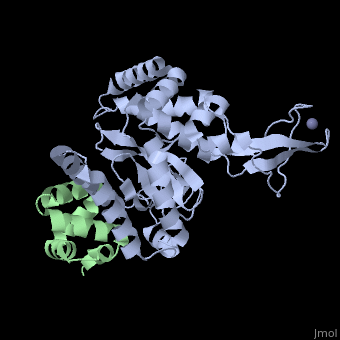2f4m
From Proteopedia
| Line 1: | Line 1: | ||
| - | [[Image:2f4m.gif|left|200px]] | + | [[Image:2f4m.gif|left|200px]] |
| - | + | ||
| - | '''The Mouse PNGase-HR23 Complex Reveals a Complete Remodulation of the Protein-Protein Interface Compared to its Yeast Orthologs''' | + | {{Structure |
| + | |PDB= 2f4m |SIZE=350|CAPTION= <scene name='initialview01'>2f4m</scene>, resolution 1.85Å | ||
| + | |SITE= | ||
| + | |LIGAND= <scene name='pdbligand=ZN:ZINC+ION'>ZN</scene> and <scene name='pdbligand=CL:CHLORIDE ION'>CL</scene> | ||
| + | |ACTIVITY= [http://en.wikipedia.org/wiki/Peptide-N(4)-(N-acetyl-beta-glucosaminyl)asparagine_amidase Peptide-N(4)-(N-acetyl-beta-glucosaminyl)asparagine amidase], with EC number [http://www.brenda-enzymes.info/php/result_flat.php4?ecno=3.5.1.52 3.5.1.52] | ||
| + | |GENE= Rad23b, Mhr23b ([http://www.ncbi.nlm.nih.gov/Taxonomy/Browser/wwwtax.cgi?mode=Info&srchmode=5&id=10090 Mus musculus]) | ||
| + | }} | ||
| + | |||
| + | '''The Mouse PNGase-HR23 Complex Reveals a Complete Remodulation of the Protein-Protein Interface Compared to its Yeast Orthologs''' | ||
| + | |||
==Overview== | ==Overview== | ||
| Line 7: | Line 16: | ||
==About this Structure== | ==About this Structure== | ||
| - | 2F4M is a [ | + | 2F4M is a [[Protein complex]] structure of sequences from [http://en.wikipedia.org/wiki/Mus_musculus Mus musculus]. Full crystallographic information is available from [http://oca.weizmann.ac.il/oca-bin/ocashort?id=2F4M OCA]. |
==Reference== | ==Reference== | ||
| - | Structure of the mouse peptide N-glycanase-HR23 complex suggests co-evolution of the endoplasmic reticulum-associated degradation and DNA repair pathways., Zhao G, Zhou X, Wang L, Li G, Kisker C, Lennarz WJ, Schindelin H, J Biol Chem. 2006 May 12;281(19):13751-61. Epub 2006 Feb 24. PMID:[http:// | + | Structure of the mouse peptide N-glycanase-HR23 complex suggests co-evolution of the endoplasmic reticulum-associated degradation and DNA repair pathways., Zhao G, Zhou X, Wang L, Li G, Kisker C, Lennarz WJ, Schindelin H, J Biol Chem. 2006 May 12;281(19):13751-61. Epub 2006 Feb 24. PMID:[http://www.ncbi.nlm.nih.gov/pubmed/16500903 16500903] |
[[Category: Mus musculus]] | [[Category: Mus musculus]] | ||
[[Category: Peptide-N(4)-(N-acetyl-beta-glucosaminyl)asparagine amidase]] | [[Category: Peptide-N(4)-(N-acetyl-beta-glucosaminyl)asparagine amidase]] | ||
| Line 22: | Line 31: | ||
[[Category: CL]] | [[Category: CL]] | ||
[[Category: ZN]] | [[Category: ZN]] | ||
| - | [[Category: | + | [[Category: glycoprotein]] |
[[Category: nucleotide excision repair]] | [[Category: nucleotide excision repair]] | ||
[[Category: peptide:n-glycanase]] | [[Category: peptide:n-glycanase]] | ||
| Line 28: | Line 37: | ||
[[Category: ubiquitin-dependent protein degradation]] | [[Category: ubiquitin-dependent protein degradation]] | ||
| - | ''Page seeded by [http://oca.weizmann.ac.il/oca OCA ] on Thu | + | ''Page seeded by [http://oca.weizmann.ac.il/oca OCA ] on Thu Mar 20 16:48:02 2008'' |
Revision as of 14:48, 20 March 2008
| |||||||
| , resolution 1.85Å | |||||||
|---|---|---|---|---|---|---|---|
| Ligands: | and | ||||||
| Gene: | Rad23b, Mhr23b (Mus musculus) | ||||||
| Activity: | Peptide-N(4)-(N-acetyl-beta-glucosaminyl)asparagine amidase, with EC number 3.5.1.52 | ||||||
| Coordinates: | save as pdb, mmCIF, xml | ||||||
The Mouse PNGase-HR23 Complex Reveals a Complete Remodulation of the Protein-Protein Interface Compared to its Yeast Orthologs
Overview
Peptide N-glycanase removes N-linked oligosaccharides from misfolded glycoproteins as part of the endoplasmic reticulum-associated degradation pathway. This process involves the formation of a tight complex of peptide N-glycanase with Rad23 in yeast and the orthologous HR23 proteins in mammals. In addition to its function in endoplasmic reticulum-associated degradation, HR23 is also involved in DNA repair, where it plays an important role in damage recognition in complex with the xeroderma pigmentosum group C protein. To characterize the dual role of HR23, we have determined the high resolution crystal structure of the mouse peptide N-glycanase catalytic core in complex with the xeroderma pigmentosum group C binding domain from HR23B. Peptide N-glycanase features a large cleft between its catalytic cysteine protease core and zinc binding domain. Opposite the zinc binding domain is the HR23B-interacting region, and surprisingly, the complex interface is fundamentally different from the orthologous yeast peptide N-glycanase-Rad23 complex. Different regions on both proteins are involved in complex formation, revealing an amazing degree of divergence in the interaction between two highly homologous proteins. Furthermore, the mouse peptide N-glycanase-HR23B complex mimics the interaction between xeroderma pigmentosum group C and HR23B, thereby providing a first structural model of how the two proteins interact within the nucleotide excision repair cascade in higher eukaryotes. The different interaction interfaces of the xeroderma pigmentosum group C binding domains in yeast and mammals suggest a co-evolution of the endoplasmic reticulum-associated degradation and DNA repair pathways.
About this Structure
2F4M is a Protein complex structure of sequences from Mus musculus. Full crystallographic information is available from OCA.
Reference
Structure of the mouse peptide N-glycanase-HR23 complex suggests co-evolution of the endoplasmic reticulum-associated degradation and DNA repair pathways., Zhao G, Zhou X, Wang L, Li G, Kisker C, Lennarz WJ, Schindelin H, J Biol Chem. 2006 May 12;281(19):13751-61. Epub 2006 Feb 24. PMID:16500903
Page seeded by OCA on Thu Mar 20 16:48:02 2008
Categories: Mus musculus | Peptide-N(4)-(N-acetyl-beta-glucosaminyl)asparagine amidase | Protein complex | Kisker, C. | Lennarz, W J. | Schindelin, H. | Wang, L. | Zhao, G. | Zhou, X. | CL | ZN | Glycoprotein | Nucleotide excision repair | Peptide:n-glycanase | Transglutaminase | Ubiquitin-dependent protein degradation

